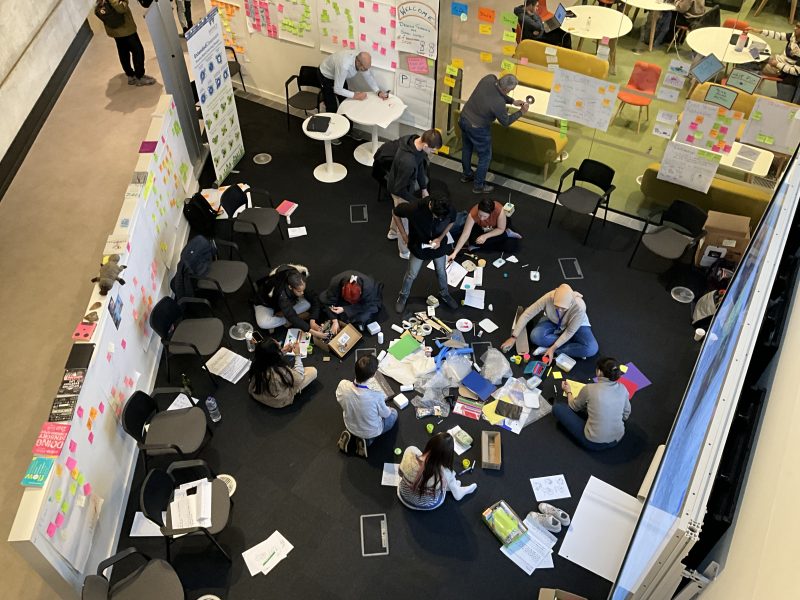
In our Design Thinking teaching we often do an exercise in which a whole class quickly generates many different responses to a challenge, using a technique to increase diversity in the responses. This can result in over 100 good ideas in under an hour. Students circulate between ideas so that they don’t ever get to stick with any single idea all the way through its development. By the end they are amazed at the quantity and quality of what they have produced. The possibilities are exciting. The students are highly motivated to go further in the next session. And most importantly, they know that the outputs are our collective production, we all own the ideas. So no one needs to be precious about defending an idea. And consequently, we can be more objective, applying critical thinking, to reduce the 100 ideas to a few to pursue further.
This is what our classes look like (this is a smaller postgrad group):

This exercise helps the students to get past a barrier to becoming an effective designerly activist (someone who can help communities to develop their own good ideas): the fixation effect – how we become over-attached to our own personal immediate responses to a challenge. The students experience the powerful force that attaches us to “our” ideas, and the ways in which Design Thinking techniques counter that force. We want them to be able to recall it and apply it in future situations (and hopefully evidenced in their assessed reflective essays). Experiencing it directly mkes it stick more firmly. In addition at key points we stop the action briefly and reflect on what is happening. We hope the students can show that they can apply the technique themselves, that they can recreate the experience for others. If that becomes part of their personal repertoire, then we’ve succeeded – they have developed their capabilities in a significant way. For us that’s what learning is: developing capabilities that can be applied to make the world a better place.
Having used Design Thinking techniques like this in “real-world” collaborations with people who are new to the approach, and having taught this many times, we know the conditions that make it work most effectively: the physical feeling of movement, circulation around the room, short fast interactions with each other and the ideas as they develop, the buzz of the room (with appropriate music playing in the background) – the physical feeling of intensity, collective purpose, of being there in the becoming of a collective. It’s something we even struggle to write about, to describe. As with most complex activities, you have to do it to get it.
But it’s not a one off. Not only do we have to complete the full cycle of idea generation (which can take several weeks), we try to repeat parts of it to give students a chance to adopt and adapt well so that it fits, sticks, spreads and grows with them. And then there are the many other aspects to the capabilities they need to develop. That, and the highly interactive learning required, takes up much of the ten weeks of the module.
So, what do we say when at the start of term one of our new students tells us that they struggle with being in busy, lively, fast-paced situations, so they just want to watch the recordings of the lectures in their own time?
We don’t do lectures, having realised a long time ago that we can’t achieve the transformations we aim for in that way. We don’t record sessions to video. We could do, if we had a big budget documentary film making crew, capable of capturing the complexity of the action. But that still wouldn’t replicate the learning experience of being and becoming in the live situation. Students would fail to get the real complex feel for it. Plus we don’t want the students to feel that their mistakes are being recorded. Making mistakes is essential (to all learning). We want them to “try, fail, try again, fail better”. The workshop is a safe space for getting things a bit wrong, or doing things that might be right, but in unexpected and uncertain ways.
So what do we do for that student? How can we include them, given their requirements, and still achieve the core goals of the module? Is it an impossible challenge?
In this case I haven’t yet got a clear answer. But i’m not just jumping to the conclusion that it is impossible. An open-mind prepared to look at it from multiple perspectives might lead to worthwhile innovations that enhance or extend our current teaching. Using a Design Thinking approach, we stand back from the specific challenge and seek inspiration from considering variations at different levels.
So i’m asking some questions:
Is it just one student? Or is there a silent minority of similar students that we don’t know about? Or maybe even a silent majority? The students we have are a small self-selected group. They do get a great experience that works for them. But maybe we could create different learning activities, maybe even a different module, that fits with others in different ways? Perhaps a version that focusses more on online collaboration (we have done that in the past when necessary). Actually Design Thinking is increasingly done by online, distant, and more asynchronous collaborations. Perhaps we could reorganise the module so that the students get to do the experiential learning with either an online bias or an on-site bias? Perhaps groups working in these different ways could collaborate on the same challenge, as they might now do in the real world? This could also enable collaboration with students (and external participants) from outside of the university. Perhaps even from other countries and continents.
And then within the activities, could we use space differently, so that a noisy and intense space is complemented by a quieter and less intense space? Maybe connected digitally? Would that be a good enough compromise for all students? It would be difficult with the rooms that we have currently available. But maybe there is a way.
Already the act of engaging with this challenge, rather than closing it down, has suggested some quite innovative possibilities. Next I plan to go wider and see if there are more possible variations. Then I will explore the ideas in detail, considering desirability and feasibility – but not just from the one student’s perspective, but from all the parties involved as well as others we don’t yet know about. Are there, for example, benefits for the other students to be found in these different apprpaches.
Keep an open mind, keep exploring, keep designig. That’s how great things happen.

A possible next step is to interview many of these students and when we really understand them create Persona Profiles. Having a rich and detailed set of profiles based on real date should enable the subsequent steps and lead to alternative and better course delivery designs.